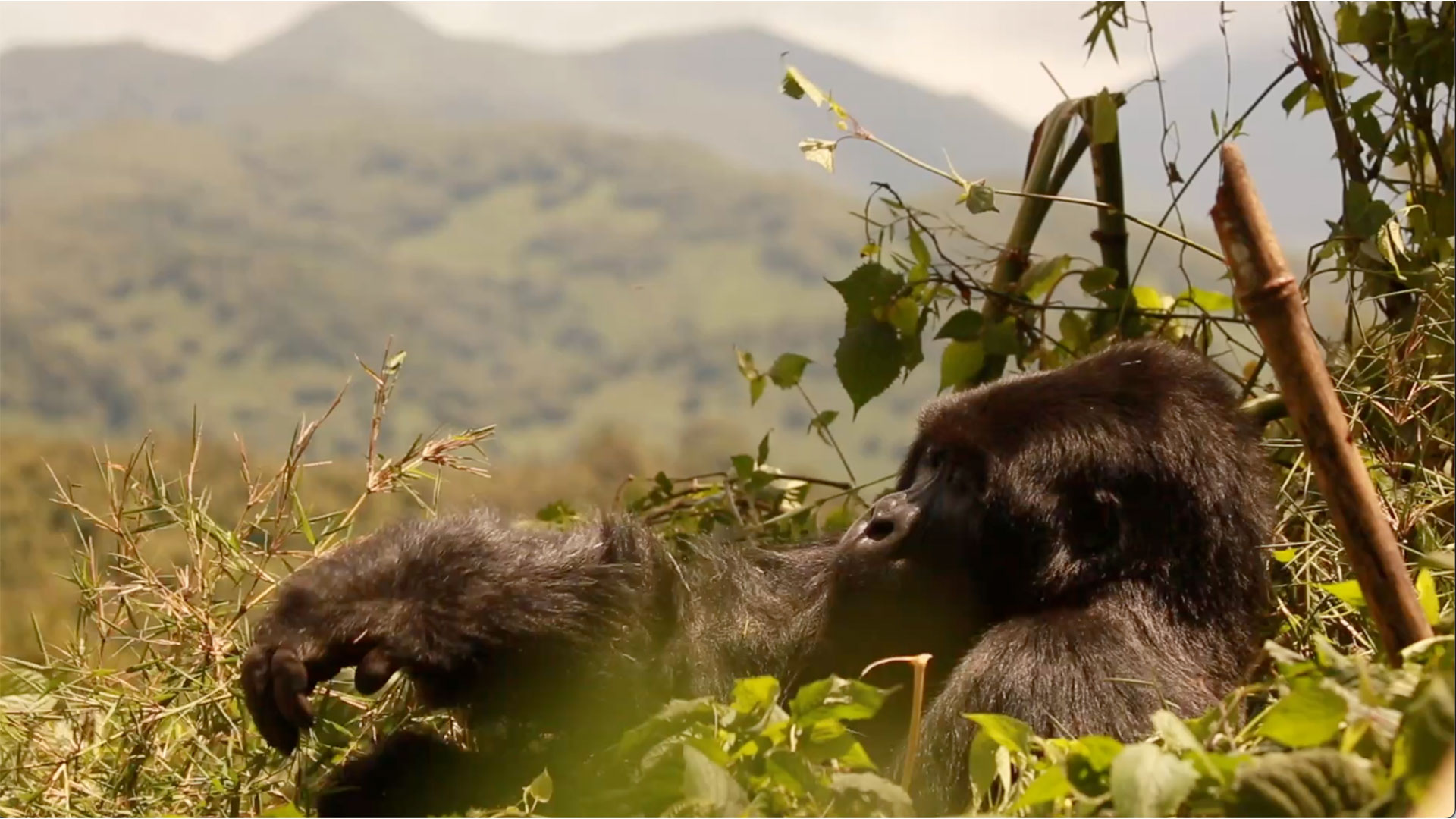Safari experts & storytellers. Since 1991

Gorilla trekking safaris
Enjoy one of Africa’s most legendary wildlife encounters, luxury lodges and exclusive gorilla experiences
Trust us to find you the rarest animals, the most spectacular wildlife events, the remotest landscapes and deeply meaningful cultural encounters!
Our favourite gorilla trekking safari ideas
These are some of our most popular gorilla tracking safaris. Many guests who want to see gorillas use these as inspiration when planning their safari with one of our safari experts.
Gorilla trekking has been described by many of our safari guests as a life-changing experience. Time spent with this fellow great ape is a humbling and profoundly spiritual experience that should be at the top of your bucket list
Gorilla trekking basics
Introduction: Gorilla trekking typically involves hiking for one to six hours to locate your assigned gorilla family group. Trackers will begin searching for your gorilla group hours before your trek starts, starting from the last-known position of the previous day. Once you have located your gorilla family group, you will spend one hour with them. Your trek group size will be limited to eight participants
Mountain vs lowland gorillas: You can spend time with mountain and lowland gorillas, which inhabit different countries and habitats
Mountain gorillas are rarer than lowland gorillas. They occur in mountainous forests in Rwanda and Uganda. The only way to see mountain gorillas is to trek to find habituated families of gorillas. See our FAQs below for detailed advice about mountain gorilla trekking
Lowland gorillas are found in low-lying forests in Congo-Brazzaville and mountainous forests in the Democratic Republic of Congo (DRC). You can either trek to find habituated gorilla family groups or wait in an elevated treehouse overlooking forest clearings (baïs) for unhabituated gorillas to appear. See our FAQs below for detailed advice about lowland gorilla trekking vs watching.
Africa Geographic specialises in the best lowland and mountain gorilla tours for those seeking an exclusive experience. Elevate your gorilla trekking with luxury accommodations, private guides, and bespoke experiences.
Private safari tours: Enjoy personalised attention with dedicated guides, private vehicles, and custom itineraries tailored to your interests and pace.
Luxury lodge experiences: Stay in Big 5 lodges featuring world-class amenities, gourmet dining, and exceptional service in stunning locations.
Fly-in safari adventures: Maximise your time with chartered flights between destinations, offering aerial views and seamless transfers to remote locations.
Trusted by thousands of satisfied travellers
✔️ 4.9 Star Trustpilot Rating ✔️ 5,000+ Safari Trips Completed
✔️ 34+ Years of Experience ✔️ 2025 Conde Nast Travel Specialist Award Winner
“I have been travelling with Christian Boix and Africa Geographic for more than a decade. Amateur photography is my hobby, and each trip has been unique, well-planned, and fulfilled my purposes... as on this trip, with my family of 11 including 5 children (7-18 yrs), to introduce them to the gorillas and chimpanzees of Uganda.... The treks into the rainforests of Kibale and Bwindi Impenetrable forests were fantastic and arduous, the golden monkeys bamboo forest allowed for fantastic photography..."
“We recently returned from a wonderful adventure through the East African countries of Uganda, Rwanda and Tanzania... From tracking chimpanzees and gorillas in Uganda to canoeing and tracking golden monkeys in Rwanda to watching the migration of wildebeests in Tanzania... The drivers and guides were very personable and knowledgeable; they did a wonderful job engaging with all of us, and, most importantly, took the time to engage with each of the children.”
“My trip to Uganda and Kenya was one of my best experiences so far. The planning went smoothly – everything was arranged exactly as I had imagined. The accommodations were excellent and met all my expectations. The diversity of landscapes and wildlife was impressive, with new highlights every day. Overall, this was my best trip yet – perfectly organised and unforgettable."
Frequently Asked Questions
Mountain gorillas
The only area in the world where you can see mountain gorillas is the Albertine Rift - a mountainous area wedged between Uganda, Rwanda and the far east of the Democratic Republic of Congo (DRC). Populations of these gentle giants are concentrated in two regions within the Albertine Rift:
The Virunga Mountains: Volcanoes National Park in Rwanda, Virunga National Park in DRC and Mgahinga Gorilla National Park in Uganda
Bwindi Impenetrable National Park in Uganda: Bwindi offers the standard one-hour gorilla encounter and a more extended gorilla habituation experience, which involves tracking non-habituated gorilla families and spending up to four hours with them
Lowland gorillas
Lowland gorillas are more widespread than mountain gorillas, but the most easily accessible places to trek for them are
Odzala Kokoua National Park in Congo-Brazzaville, where you will track the western lowland gorilla
Kahuzi-Biega National Park in the Democratic Republic of Congo (DRC), where you will track the eastern lowland (Grauer's) gorilla - the largest of all gorillas
Gorilla trekking involves walking in mountainous areas to find habituated gorilla families. You will spend a maximum of one hour with them and only trek once per day. The gorilla family group will usually be nearby, and you will need to wear medical masks to protect them against human diseases. You need to be fit to walk for two to four hours at a relaxed pace. A gorilla trekking permit is required. Gorilla trekking occurs in Uganda, Rwanda, the Democratic Republic of Congo (DRC) and Congo-Brazzaville
Gorilla watching (only available in Congo-Brazzaville) involves waiting in elevated treehouses overlooking forest clearings (baïs) for unhabituated gorillas to appear. There is no time limit to watching these gorillas, and you may enjoy multiple gorilla sightings, depending on how long you remain in the treehouse. No medical mask or permit is required, and the walk to the treehouse is usually short and not strenuous.
Trekking rules are essential to protect the health of the gorillas, which are susceptible to human diseases. Gorillas will be stressed if there are too many visitors or if visitors misbehave.
Feeling sick?
If you show any sign of illness on the day of your trek, please let your guide or the park staff know. They may decide to prevent you from trekking on that day. Exposing gorillas to disease may be catastrophic for the entire population. Also, if you are in the company of gorillas and need to cough or sneeze, please look away and cover your face with a cloth. Some parks expect you to wear a mask when in the company of gorillas and chimpanzees.
Group size and frequency
Each gorilla group is visited daily - only once. Group size is limited to 6 or 8 tourists, and the interaction is limited to one hour.
Minimum visitor age
The minimum age for tourists is 15 years old, to prevent exposing the gorillas to childhood diseases such as mumps, chickenpox, measles, etc.
Photography
Flash photography is not permitted - the flash may frighten the gorillas or provoke an aggressive reaction.
Minimum distance
Tourists must remain at least seven metres from the gorillas. Gorillas may approach you, in which case you should retreat slowly if possible.
Stay together
Try to remain in a tight group - to make it easier for your guides to manage the situation and to prevent the gorillas from feeling threatened.
Your behaviour while with gorillas
Remain seated or crouching and keep your arms at your side when spending time with gorillas. Keep quiet - even when filming a selfie. Shouting, standing or gesturing with your arms may be perceived as a threat by gorillas. Silverback gorillas have been known to beat their chests, roar and even charge at tourists. If this happens, remain seated and avoid eye contact with the gorilla. These threat displays look and sound scary, but the gorillas soon calm down and go about their business without harming anybody.
Eating, drinking & smoking
No eating, drinking or smoking is permitted anywhere near gorillas. This may attract their attention, leading to unwelcome close encounters. Your food may also be bad for gorilla health.
Toilet
Please go to the bathroom before you set out. If you need to go to the toilet whilst in the forest, you will need to dig a deep hole to bury any excrement and fill the hole up afterwards. Your guides will lend you a machete for this purpose, but you will need to bring toilet paper.
Litter
Please keep all of your rubbish in your backpack and deposit it at your lodge after the trek.
The dry seasons - mid-December to early February and June to September - are more comfortable for trekking. That said, don't be completely put off by the rains of November and March-May, as you will have the forests, mountains, guides and gorillas to yourself.
A mountain gorilla trek permit usually costs US$700 per trek in Uganda, US$1,500 in Rwanda and US$400 in the DRC. A mountain gorilla habituation experience permit in Uganda costs US$1,500. Lowland gorilla trekking permits cost $750 per trek, whereas lowland gorilla watching from an elevated treehouse does not incur a trekking permit fee.
These prices may change during off-peak trekking periods, and discounts are often available for local or regional travellers. The proceeds from these permits are directly allocated toward protecting these species in the respective countries. The gorilla trekking permit generates revenue for government conservation efforts and creates ecotourism jobs for rangers, trackers and porters. Local communities also benefit from additional knock-on business opportunities related to tourism. These benefits ensure that local people value gorillas and their habitat.
We will advise you of the exact prices once you provide your travel dates. The cost of your gorilla safari lodge varies based on the luxury level, location, and time of year. Our ready-made packages provide our suggested lodge options.
Other animals in the region include forest elephants, forest buffalo, duikers, forest hogs, bush pigs, golden cats, jackals and civets. It should be noted, though, that sightings are rare due to the thick vegetation. There are 1,074 bird species in the Albertine Rift, of which 42 occur only there, and you can expect to tick off many colourful birds as you hike.
The hiking pace during gorilla treks is relaxed - expect frequent stops to admire the incredible views or identify a bird. But high humidity and steep hills take their toll - you should be fit enough to walk for 2-4 hours at a relaxed pace. Watching gorillas from elevated treehouses requires a low level of fitness.
The minimum gorilla trekking age is 15 years. There is no maximum age
What to pack: Water, snacks for while you walk, lunch, raincoat (all available from your lodge), several layers of clothing including a warm top, long-sleeved shirt and long pants, wide-brimmed hat, hiking shoes/boots, towel, insect repellent and equipment such as binoculars, cameras and lenses
Backpack: Take a day pack for the above items
Porters: Hire a porter for the hike - he will carry your backpack - freeing you to carry only binoculars and perhaps a camera. The cost is a fraction of your daily expenses in gorilla-land, yet it makes a big difference in the porter's life
Photography: The forest is dark, and the use of large lenses will be limited. Keep that big lens in your backpack, and use a general-purpose lens on your camera. Keep a dry lens cloth handy to wipe away dew and raindrops. Flash photography is not permitted while with the gorillas
Waterproofing: Carry a few waterproof bags for equipment in case of showers and high humidity
Mask: Gorilla treks require the use of a surgical mask while you are with the gorillas
Weather: Mountain gorilla treks are at high altitudes in high rainfall areas. The weather can swing from clear and hot to torrential rain and cold in minutes.
We have been handcrafting experiential safaris since 1991. Travel in Africa is about knowing when and where to go, and with whom. A few weeks too early/late or a few kilometres off course, and you could miss the greatest show on Earth. And wouldn’t that be a pity?
Booking through a respected tour operator with many years of experience means that all you need to focus on is helping us design your safari and then having a superb vacation. The rest – all the nitty-gritty detail and admin – is done while you relax. Our 24/7 concierges take care of problems such as flight changes and missed flights, last-minute road-transfer and lodge changes due to unexpected events, and itinerary changes requested by you.
Remember that you will not save money by attempting to book and manage your own safari, but you will inherit mistakes and problems that arise.
You only make your first payment when you book your gorilla tour. Your second (last) payment is about 90 days before you travel.
Yes, your money is safe. Your payments go into a third-party TRUST ACCOUNT – protecting them in the unlikely event of a financial setback on our part. Also, we are members of SATSA who attest to our integrity, legal compliance and financial stability. See what travellers say about us.
Yes, your gorilla trek has become a vital financial lifeline for conserving the last remaining mountain gorillas and their highland habitat. The gorilla trekking permit generates revenue for government conservation efforts and creates ecotourism jobs for rangers, trackers and porters. Local communities also benefit from additional knock-on business opportunities related to tourism. These benefits ensure that local people value gorillas and their habitat.
Also, by booking your safari with Africa Geographic, you make a significant difference because:
We donate a portion of every safari sold to selected conservation efforts at ground level
Your safari supports our conservation publishing efforts, which educate the world about Africa's incredible biodiversity and the local people who protect it
Our chosen lodges support local community initiatives, ensuring that tourism benefits the nearby villages directly. They also adhere to strict environmental practices, such as limited vehicle numbers and sustainable camp operations, which help protect the ecosystem
YOUR safari choice does make a difference – thank you!
Click here to schedule a no-obligation call with one of our Safari Experts or fill in our 2-minute form with your questions. Our team of experts are here to help! Whether you’re curious about the best time to travel, want to hear first-hand about an experience or need help planning you safari.
HOW IT WORKS
1. You describe your dream gorilla safari in Africa
2. One of our safari experts will tailor-make your holiday
3. After minor admin, you have the time of your life!
RESOURCES
1. Ready-made lowland and mountain gorilla tours to help you describe YOUR dream safari - see below
2. Tons of helpful info about the best experiences & destinations plus safari advice - see the tabs above
LET'S START PLANNING
1. Contact us via an enquiry form - click the red 'Plan my dream safari' button at the top of this website or scroll to the end of this page
2. Speak with a safari expert - click the telephone icon at the top of this website
Gorilla trekking tour ideas
Swipe to view the best gorilla safaris in Africa. Many of our guests use these as inspiration when planning their trip with one of our safari experts.
Start planning your dream safari
Our travel experts will craft a no-obligation itinerary just for you. We have crafted over 5,000 safaris since 1991. Your personal details are protected; we only use this information to contact you.

Why choose us to craft your safari?
Handcrafted experiential safaris since 1991.
Travel in Africa is about knowing when and where to go, and with whom. A few weeks too early/late or a few kilometres off course, and you could miss the greatest show on Earth. And wouldn’t that be a pity?

Trust & Safety
Guest payments go into a third-party TRUST ACCOUNT - protecting them in the unlikely event of a financial setback on our part. Also, we are members of SATSA who attest to our integrity, legal compliance and financial stability.
Make a difference
We donate a portion of the revenue from every safari sold to carefully selected conservation projects that make a significant difference at ground level.
YOUR safari choice does make a difference - thank you!


